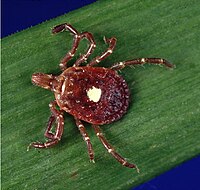
Chemical cues shaping host-seeking by entomopathogenic nematodes.
Sign Up to like & getrecommendations! Published in 2021 at "Current opinion in insect science"
DOI: 10.1016/j.cois.2021.03.011
Abstract: Entomopathogenic nematodes (EPNs) are obligate parasites that infect a broad range of insect species. Host-seeking is a crucial step for EPN infection success and survival. Yet, the identity and ecological functions of chemicals involved in… read more here.
Keywords: entomopathogenic nematodes; host seeking; chemical cues; shaping host ... See more keywords

Mosquito Host-Seeking Regulation: Targets for Behavioral Control.
Sign Up to like & getrecommendations! Published in 2019 at "Trends in parasitology"
DOI: 10.1016/j.pt.2019.06.010
Abstract: Female Aedes aegypti mosquitoes require protein from blood to develop eggs. They have evolved a strong innate drive to find and bite humans and engorge on their blood. Decades of research have revealed that attraction… read more here.
Keywords: control; host seeking; blood; host ... See more keywords

Turkey tick news: A molecular investigation into the presence of tick-borne pathogens in host-seeking ticks in Anatolia; Initial evidence of putative vectors and pathogens, and footsteps of a secretly rising vector tick, Haemaphysalis parva.
Sign Up to like & getrecommendations! Published in 2020 at "Ticks and tick-borne diseases"
DOI: 10.1016/j.ttbdis.2020.101373
Abstract: This Turkey-based study investigated the presence of various tick-borne microorganisms in a broad-range of host-seeking ticks (n = 1019) that exhibit both hunter and ambusher characteristics. All collected ticks were analyzed individually via PCR-sequencing, resulting in the… read more here.
Keywords: babesia; host seeking; tick borne; presence ... See more keywords

Theileria orientalis Ikeda in host-seeking Haemaphysalis longicornis in Virginia, U.S.A.
Sign Up to like & getrecommendations! Published in 2020 at "Ticks and tick-borne diseases"
DOI: 10.1016/j.ttbdis.2020.101450
Abstract: The Asian longhorned tick, Haemaphysalis longicornis, has recently become established in the United States. In East Asia, Australia, and New Zealand, the native and previously introduced ranges, this tick is a vector of an important… read more here.
Keywords: longicornis; host seeking; haemaphysalis longicornis; orientalis ikeda ... See more keywords

Using haem concentration as a metric of physiological age to infer demographic structure in natural field and forest populations of host-seeking Amblyomma americanum adults
Sign Up to like & getrecommendations! Published in 2020 at "International Journal of Acarology"
DOI: 10.1080/01647954.2020.1758776
Abstract: ABSTRACT Understanding how patterns of host-seeking behaviour differ across demographic classes in Amblyomma americanum (L.), the lone star tick, is essential in evaluating species potential as a vector of pathogens. Our objective was to characterize… read more here.
Keywords: concentration metric; host seeking; amblyomma americanum; haem concentration ... See more keywords

Reported County-Level Distribution of Seven Human Pathogens Detected in Host-Seeking Ixodes scapularis and Ixodes pacificus (Acari: Ixodidae) in the Contiguous United States
Sign Up to like & getrecommendations! Published in 2022 at "Journal of Medical Entomology"
DOI: 10.1093/jme/tjac049
Abstract: Abstract Tickborne disease cases account for over 75% of reported vector-borne disease cases in the United States each year. In addition to transmitting the agents of Lyme disease (Borrelia burgdorferi sensu strict [Spirochaetales: Spirochaetaceae] and… read more here.
Keywords: distribution; county level; host seeking; united states ... See more keywords

Seasonal activity patterns of host-seeking Ixodes scapularis (Acari: Ixodidae) in Minnesota, 2015-2017.
Sign Up to like & getrecommendations! Published in 2023 at "Journal of medical entomology"
DOI: 10.1093/jme/tjad048
Abstract: As the primary vector of Lyme disease spirochetes and several other medically significant pathogens, Ixodes scapularis presents a threat to public health in the United States. The incidence of Lyme disease is growing rapidly in… read more here.
Keywords: 2015 2017; ixodes scapularis; phenology; lyme disease ... See more keywords

Host-seeking activity of adult Culicoides sonorensis (Diptera: Ceratopogonidae) during winter in southern California, USA, and assessment of bluetongue virus overwintering.
Sign Up to like & getrecommendations! Published in 2023 at "Journal of medical entomology"
DOI: 10.1093/jme/tjad049
Abstract: In southern California, USA, annual reoccurrence of bluetongue infection in cattle (Bos taurus Linnaeus (Artiodactyla: Bovidae)) suggests that bluetongue virus (BTV) persists year-round but escapes detection during cooler months, reappearing when the weather gets warmer.… read more here.
Keywords: host seeking; southern california; adult; winter ... See more keywords

Fat body–specific vitellogenin expression regulates host-seeking behaviour in the mosquito Aedes albopictus
Sign Up to like & getrecommendations! Published in 2019 at "PLoS Biology"
DOI: 10.1371/journal.pbio.3000238
Abstract: The high vector competence of mosquitoes is intrinsically linked to their reproductive strategy because females need a vertebrate blood meal to develop large batches of eggs. However, the molecular mechanisms and pathways regulating mosquito host-seeking… read more here.
Keywords: seeking behaviour; host seeking; mosquito; expression ... See more keywords

Why Lyme disease is common in the northern US, but rare in the south: The roles of host choice, host-seeking behavior, and tick density
Sign Up to like & getrecommendations! Published in 2021 at "PLoS Biology"
DOI: 10.1371/journal.pbio.3001066
Abstract: Lyme disease is common in the northeastern United States, but rare in the southeast, even though the tick vector is found in both regions. Infection prevalence of Lyme spirochetes in host-seeking ticks, an important component… read more here.
Keywords: host seeking; disease common; host; lyme disease ... See more keywords

Current evidences of the efficacy of mosquito mass-trapping interventions to reduce Aedes aegypti and Aedes albopictus populations and Aedes-borne virus transmission
Sign Up to like & getrecommendations! Published in 2023 at "PLOS Neglected Tropical Diseases"
DOI: 10.1371/journal.pntd.0011153
Abstract: Background Over the past decades, several viral diseases transmitted by Aedes mosquitoes—dengue, chikungunya, Zika—have spread outside of tropical areas. To limit the transmission of these viruses and preserve human health, the use of mosquito traps… read more here.
Keywords: mass trapping; control; transmission; efficacy ... See more keywords